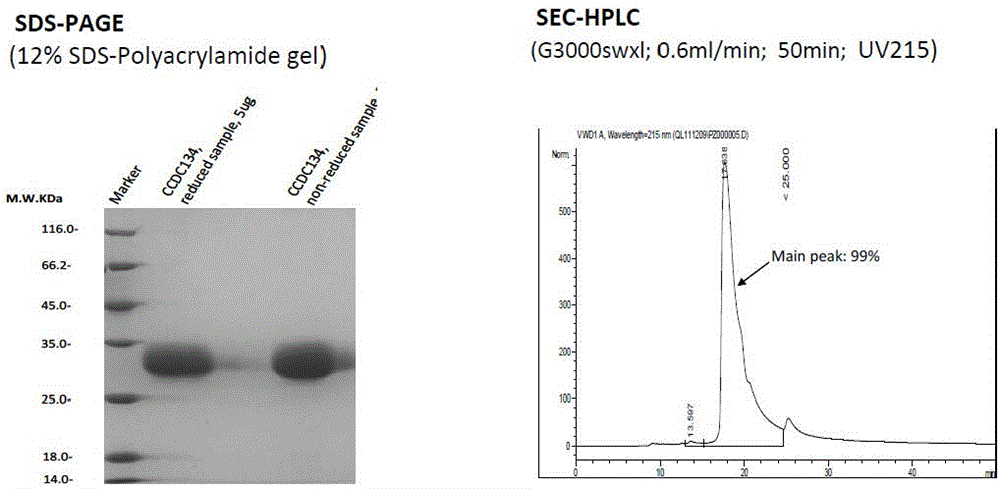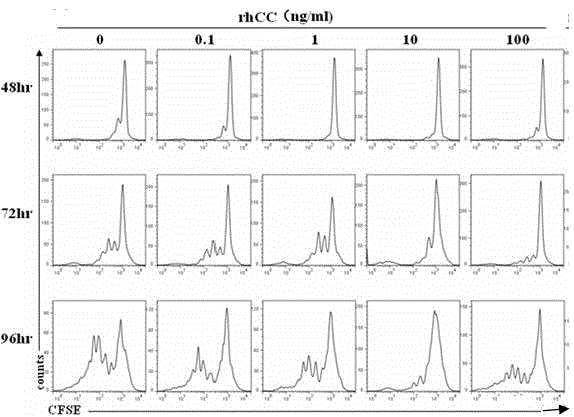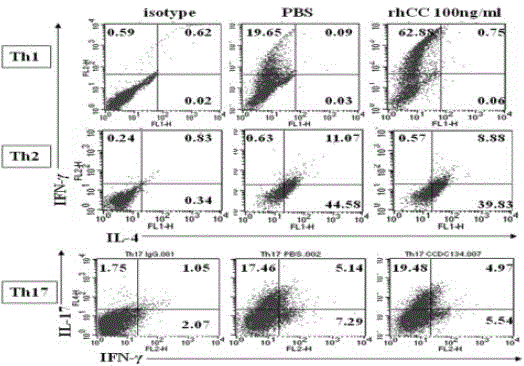Application of human cell factor CCDC134 to autoimmune diseases
An autoimmune and cytokine technology, applied in allergic diseases, disease diagnosis, nervous system diseases, etc., can solve the problems of underdeveloped functions and affect the anti-bacterial immunity of macrophages, so as to reduce infiltration and alleviate EAE The effect of disease
- Summary
- Abstract
- Description
- Claims
- Application Information
AI Technical Summary
Problems solved by technology
Method used
Image
Examples
Embodiment 1
[0048] Embodiment 1: Preparation of recombinant human CCDC134 protein
[0049] 1.1 Constructed pMH-CCDC134-his6 fusion protein expression plasmid for expressing CCDC134-his6 fusion protein
[0050] Method: Insert the coding sequence of CCDC134 (SEDIDNO: 1) into the pMH expression vector (Biovector, operated according to the instruction manual) to construct the pMH-CCDC134-his6 expression plasmid (SEQ ID NO: 4), where the sequence of SEQ ID NO: 4 is: start codon atg-IgK signal peptide gene (human immunoglobulin Kappa light chain signal peptide)-CCDC134 coding gene that removes its own signal peptide-6 histag-stop codon tag.
[0051] Result: The sequence of the coding region was correct after DNA sequencing ( figure 1 ).
[0052] 1.2 Perform SDS-PAGE and WB to verify the expression and purification of the target protein
[0053] Method: After the correctness of the plasmid was verified by sequencing, Jiangsu Taicang Minor Hengkang Biotechnology Co., Ltd. was entrusted to prep...
Embodiment 2
[0055] Example 2: Separation and purification of CD4 by recombinant human CCDC134 protein + Effects on T lymphocyte proliferation
[0056] 2.1 Human CD4 + Acquisition of T lymphocytes
[0057] Methods: A 2U concentrated leukocyte blood sample was obtained from Beijing Blood Center. First, normal human peripheral blood mononuclear cells (peripheral blood mononuclear cell, PBMC) were isolated from normal human peripheral blood using lymphocyte separation medium, and then CD4 + T cell positive sorting magnetic beads (refer to the product manual) to obtain CD4 + T lymphocytes; CD4 separated from magnetic beads + Add mouse anti-human CD45RO antibody and rat anti-mouse IgG2a sorting magnetic beads to T lymphocytes to remove CD45RO + cells, the remaining cells are CD45RA + na?ve T lymphocytes. Take a portion out of it (5×10 5 ), and its purity was detected by FACS, the steps are as follows: add 200 μL of pre-cooled blocking solution (5% FBS / PBS, v / v), block at 4 °C for 30 min,...
Embodiment 3
[0063] Example 3: Recombinant human CCDC134 protein to na?veCD4 + Influence of T lymphocyte differentiation process
[0064] 3.1 Isolation of human CD4 +Na?veT cells and Th1, Th2 and Th17 cells induced in vitro, and the role of recombinant human CCDC134 protein in the differentiation process was detected
[0065] Methods: Firstly, na?veT lymphocytes were obtained by magnetic bead sorting; in order to induce the differentiation of na?veT cells in vitro, we cultured them in cells coated with anti-CD3 (1 μg / mL; cloneOKT3) and anti-CD28 (2 μg / mL) ; clone15E8) antibody in cell culture plates, stimulating its activation and proliferation. If Th1 cells are induced, add recombinant human IL-12 (2.5ng / mL), recombinant human IL-2 (10ng / mL) and anti-IL-4 antibody (5μg / mL) to the culture system; if Th2 cells are induced , then add recombinant human IL-4 (12.5ng / mL), recombinant human IL-2 (10ng / mL), anti-human IFN-γ (5μg / mL; cloneB-B) and anti-human IL-10 to the culture system (5μg / mL...
PUM
 Login to View More
Login to View More Abstract
Description
Claims
Application Information
 Login to View More
Login to View More - R&D
- Intellectual Property
- Life Sciences
- Materials
- Tech Scout
- Unparalleled Data Quality
- Higher Quality Content
- 60% Fewer Hallucinations
Browse by: Latest US Patents, China's latest patents, Technical Efficacy Thesaurus, Application Domain, Technology Topic, Popular Technical Reports.
© 2025 PatSnap. All rights reserved.Legal|Privacy policy|Modern Slavery Act Transparency Statement|Sitemap|About US| Contact US: help@patsnap.com



